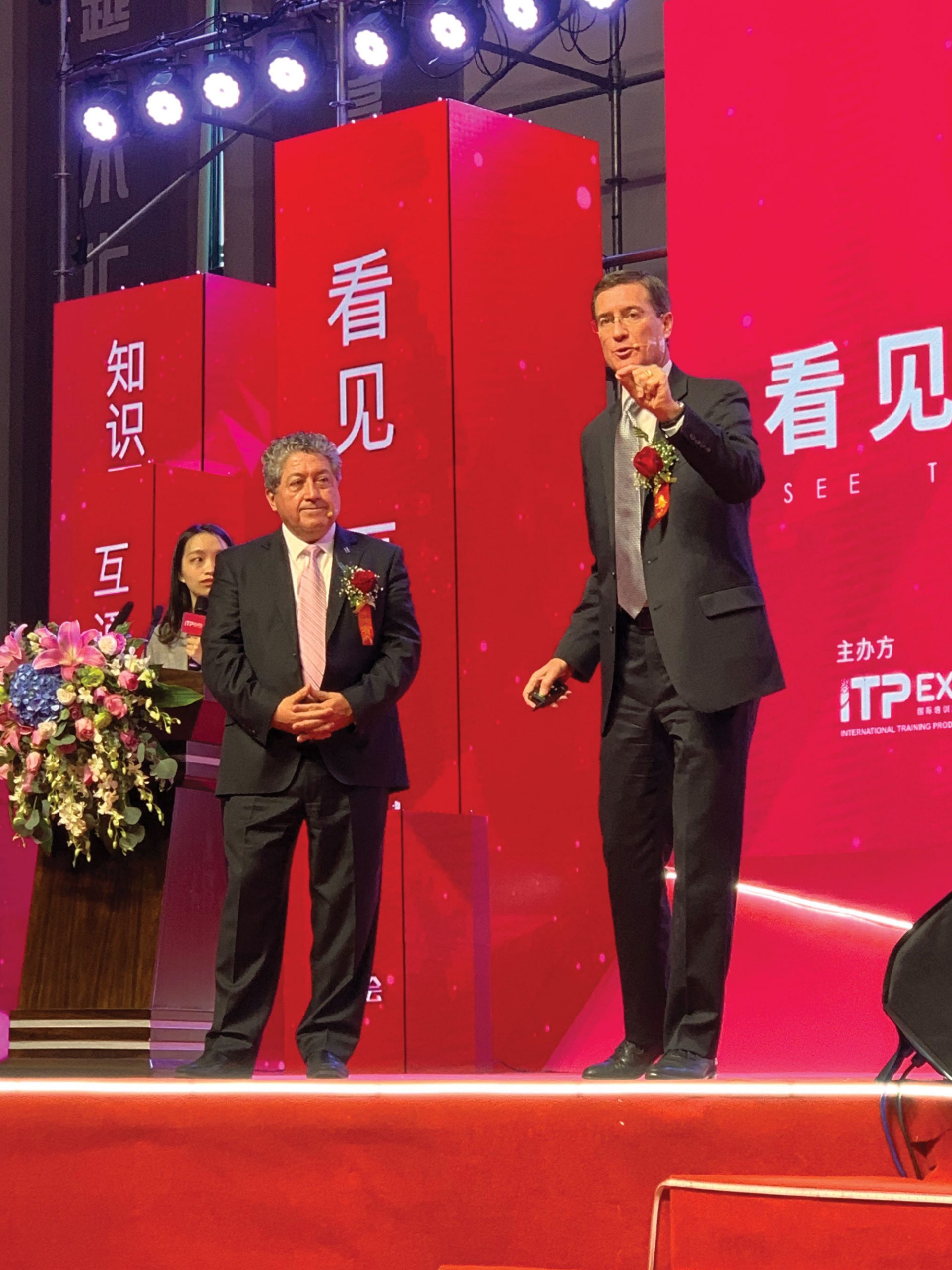Intentionally shaping and managing a unified company culture is critical for CEOs who run global organizations
A strong global culture aligns an organization regardless of where employees “sit” relative to geography. It provides a roadmap for employees to understand and support the company vision, mission, and business results, whether that’s increased revenue growth or new product development. Further, it aligns the organization around the global strategic vision and facilitates operations across divisions, regions, and countries.
While the benefits are unmistakable, it can be challenging to design a global culture. How do company leaders agree on what that culture looks like? Once they do, how do they build a global workplace culture while respecting geographical cultural nuances? Does global culture ever translate well across borders?
We offer a five-step process to show leaders what it takes to create a united global culture that is clear and consistent for all employees, no matter where in the world they work.
 Identify organizational key results with the global leadership team
Identify organizational key results with the global leadership team
An important first step to building a global culture is identifying the top outcomes, or key results, that the organization must achieve as a whole. These are the measure of a company’s success. They are the “must deliverables” that sustain the organization’s health, well-being, strength, viability, and growth. They guide every employee’s daily decisions, providing the clarity needed for everyone to align around priorities and contribute to the company’s success.

The key results vary from company to company, from higher profits, reduced employee turnover, or a lower carbon footprint, depending on the needs of the business. Effective results are memorable, measurable, and meaningful to every employee.
This process calls for leaders to rigorously identify the three results that are critical to the organization’s success. As complexity increases through technology, new customer expectations, or a geographically dispersed workforce, so does the need for more focus and alignment. Therefore, the fewer key results you have, the easier it is to connect all of your employees to the fundamental and essential nature of your business.
Equally important is to ensure that everyone in the company can impact key results, regardless of geography. This encourages global accountability and alignment. Take an international natural resource company based in Indonesia with a location in Italy. Its global leadership team is more likely to buy in to a key result of an additional 3% growth year over year when it benefits the company and serves the mission rather than enriching the headquarters in one country. It’s a key result that all employees can support.
 Create a common definition of global business culture
Create a common definition of global business culture
The results an organization achieves are a byproduct of its culture, the way that people think and act within an organization. What can leaders do when an organization needs to produce different results?
Leaders often attempt to change the way people in the organization act. They create new policies, processes, or organizational structures that don’t address the root cause of performance: the way people in the organization think and what they believe about the business. It’s no surprise that these action-based tactics don’t work, at least not for the long haul.
If leaders establish a key result that requires quick and agile execution, and only 10% of employees strongly agree that their company is a speed-to-market leader (according to data from our Culture Advantage Index®), how will employees show up every day at work? What would it look like if leaders could reshape that belief so a greater majority (dare we say all) of employees believe that the organization can and will be a speed-to-market leader?
Leaders get intentional about managing culture by identifying new beliefs that reflect the new culture mindset. These may be as simple as “Discover and consider the client’s needs in everything I do” or “Consistently seek and offer candid, honest, and respectful feedback.” These beliefs focus the change effort; they’re a blueprint that guide the organization to deliver the desired results.
Take the case of a global company with a call center in Costa Rica. Leadership identified a key result to increase revenue by 30%. The beliefs the organization developed were “Act Now” and “Customer Focused.” Demonstrating these beliefs, call center employees had a direct impact on the key result of revenue growth by responding to incoming calls quickly and resolving customer issues within a certain number of days.
This behavior boosted the company’s reputation as customers began recommending the organization to others. New customers and repeat business led to increased revenue. The business leaders never had to direct call center employees to think about revenue. Instead, they connected the desired behavior to something meaningful: helping customers resolve issues quickly.
 Remove barriers that stand in the way of adoption
Remove barriers that stand in the way of adoption
Critical to managing culture and gaining buy in from employees is removing the barriers that impede employees from adopting change. And one of the biggest barriers is language.
A large pharmaceutical company with locations in Russia and the Middle East was dealing with pessimism among the global workforce after several failed product launches. Employees felt incapable of developing new products and made excuses for poor performance.
To create new products, leadership realized it would have to shift the negative mindset prevalent in the organization. They designed a program that would address employees’ beliefs getting in the way of progress and inspire greater ownership of product development. They tailored the program for each country.
Local managers interviewed their staff to gather information about compliance and processes impacting product launches. Uncovering these specific pain points provided insights that guided the champions. They rolled out a program tailored to address local needs, including local language.
Our research indicates that language is an essential mechanism to encouraging employees in different locations to adopt change. When leaders show cultural sensitivity and respect, they’re more likely to get employees to listen to the company message and adopt a new business culture.
 Create the right experiences that support the new business culture
Create the right experiences that support the new business culture
Creating experiences for employees is a powerful culture management tool. According to The Results Pyramid® model, experiences shape personal beliefs, which in turn, influence actions. Finally, actions drive results—whether good or bad. As such, any sustainable culture work begins at the bottom layer of the pyramid: by purposefully shaping employees’ experiences.
In global organizations, creating the right experiences often requires a deep sensitivity to the country-specific culture and what that country values as a society. A global oil company based in Southeast Asia did this when it incorporated its culture beliefs in the daily prayers that its employees perform onsite.
Or consider the global company with a mission statement that included a reference to the country where headquarters was based. Every time leadership read the mission statement at all-hands meetings, employees who worked in other countries were put off. The experience led to a belief among those employees that headquarters didn’t care about them. In this case, it was a simple fix: the company removed the country name from the mission statement.
The leader has an opportunity to create a positive or negative experience for the workforce.
Global leaders that consciously honor the culture are wise and humble. They ask what’s appropriate in a certain country and listen to employees and local management. It’s the same reason culturally sensitive CEOs don’t include images of landmarks or sports references from their country of origin when giving a presentation at a company location in another country. Instead, they honor the local culture with references that appeal to their local audience.
Another way to create experiences that shift behavior and unify a global culture is through frequent feedback and immediate recognition. In some cultures, feedback and recognition are not easily accepted. But both are crucial to reinforcing behaviors that help a company achieve its key results. It’s important for leaders to show the value of constructive feedback and instant recognition to their employees. One way to do that is to lead by example. If a CEO and the global leadership team accept feedback and act on it, they demonstrate that it’s safe for employees to do the same.
A global company based in Sweden encouraged its leadership team to step outside its comfort zone and practice exchanging constructive feedback. During the exercise, an employee at the director level was invited to offer feedback to an executive. She started with appreciative feedback. He paid very little attention until she began giving him candid feedback pertaining to a meeting they had both attended. At that moment, his body language changed. He grabbed a pen and started to write, attentive to what he needed to do differently as a leader. In a brief exercise that valued honesty and vulnerability, both the director and the leader learned the power of constructive feedback.
When it comes to employee recognition, many leaders reserve comments about positive performance for annual reviews, company meetings, or awards. But that’s not enough to change the culture day in and day out and move the company forward. Consider the belief we discussed earlier: “Discover and consider the client’s needs in everything I do.” As a leader, your role is to acknowledge immediately when employees act on that belief. It engages employees and communicates how their daily tasks directly impact achieving key results. The challenge is doing so in countries where recognition makes people uncomfortable.
Take Great Britain, where recognition may elicit nervous laughter. Rather than embarrassing a reserved employee with public praise, a leader can recognize the employee in a more private setting, such as during a one-on-one meeting. Global leaders can learn to be sensitive to those cultural differences and find appropriate ways to instantly recognize employees and reinforce the new business culture.
 Be sensitive to geopolitical pressures
Be sensitive to geopolitical pressures
Employees and local leaders in different countries may face pressures unlike those at headquarters or other locations. These may vary from ongoing political situations to natural disasters and sudden tragedies. It’s important to acknowledge these situations, because local pressures can affect how employees think, feel, and interpret experiences. And local pressures can impact job performance.
Consider the leader of a global company who arrives in a country that has just experienced a natural disaster. She had planned to facilitate a culture management coaching session for leaders, but employees weren’t in the mood. Many had lost family members in the tragedy. The leader has an opportunity to create a positive or negative experience for the workforce. She could say employees had to attend no matter what. Or she could mourn with them, ask what could bring them peace, and postpone the session.
Building Strong Culture
It can be challenging to implement a cohesive global culture within an organization that spans multiple countries, but it is quite achievable. It does require perseverance and intentionality from the leadership team.
Global leaders who want to move their organizations forward can do so by working closely with their leadership team to identify their top key results and then determine what employee behaviors have to change to reach those results. They can engage local champions to roll out change in the local language. And they can create experiences that encourage new behaviors, while at the same time being humble and compassionate in the face of geo-political pressures.
The result will be a business culture that translates across borders. One that not only supports an organization’s goals, but also improves operations and unites employees, no matter where they sit.





